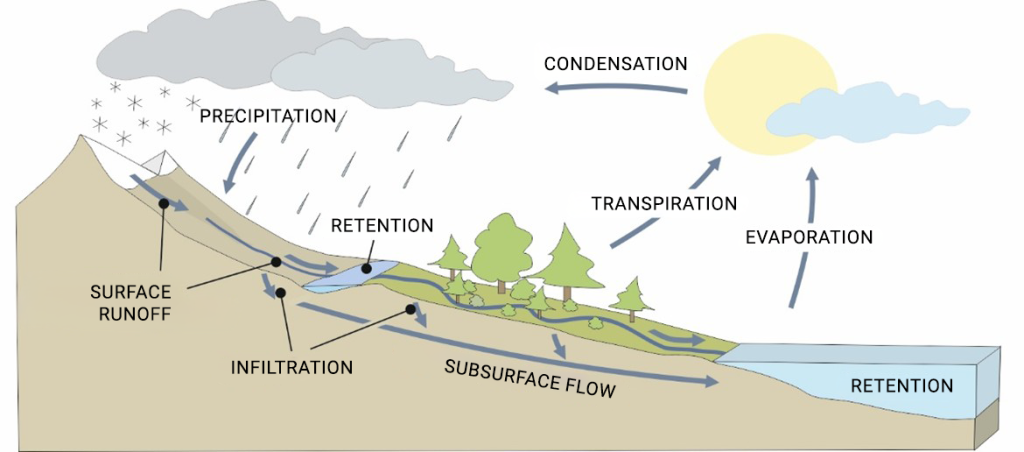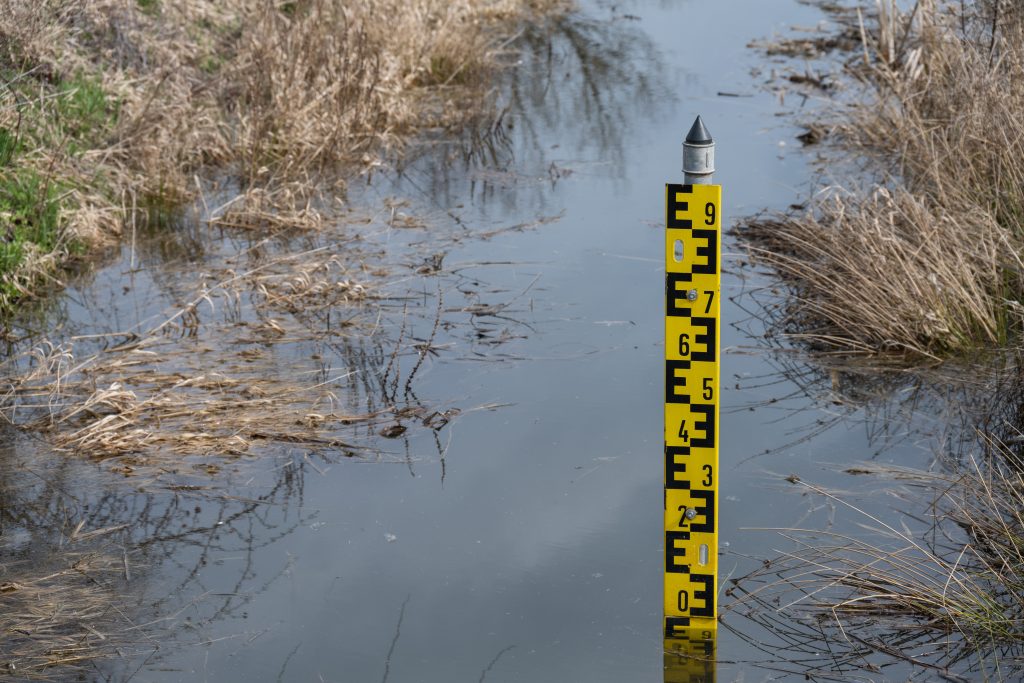The hydrological year, covering the period from November 1st to October 31st of the following year, is used to analyze the full cycle of water circulation in nature. This division takes into account autumn and winter rainfall and snowfall, which are stored in the environment, as well as spring thaw, which determines river flows, groundwater levels, and the retention capacity of land areas. Based on data from the hydrological year, it is possible to identify the occurrence of hydrological drought, characterized by a prolonged decrease in water levels in rivers, lakes, and reservoirs. This phenomenon is typically preceded by meteorological drought and agricultural drought.
Meteorological drought occurs when precipitation remains below the accepted long-term average over an extended period. If this deficit persists, the soil gradually dries out, leading to a lack of water essential for plant growth—this stage is known as agricultural drought. The next phase is hydrological drought, which arises when the supply of surface and groundwater becomes insufficient. The most visible manifestation of this phenomenon is low flow periods, known as “low water levels,” where river flows fall below average values. Prolonged hydrological drought can lead to severe consequences for both the economy and the environment.

Figure 1. Diagram of the Hydrological Cycle; www.epodreczniki.open.agh.edu.pl (2025)
According to data published by Institute of Meteorology and Water Management – National Research Institute in the latest hydrological yearbook, Poland faced a significant rainfall deficit in many regions during the last hydrological year. In particular, the western and southwestern parts of the country experienced precipitation levels well below the long-term average during the first half of the hydrological year, resulting in substantial water resource shortages. The situation changed in September when heavy rainfall associated with cyclonic systems brought annual precipitation levels to the norm in southwestern Poland. In some areas, such as Lower Silesia (Dolny Śląsk) and the Opole region, total precipitation in September exceeded 150–200 mm, leading to flooding and inundations. This significantly raised water levels in rivers such as the Oder and Nysa Kłodzka.
Despite the intense rainfall, the rainy September did not alleviate the hydrological problems across the entire country. In northeastern Poland, hydrological drought was still observed, resulting from several months of precipitation deficit. In regions such as Podlasie and Warmia-Mazury, the annual precipitation total was 30-40% below the long-term average, leading to water supply issues in agriculture and other sectors of the economy. This contrast clearly shows how local weather anomalies can aggravate existing imbalances in Poland’s water balance.
Data analysis for the example meteorological station in Warsaw for the last hydrological year shows that the rainfall deficit intensified mainly at the end of spring and the beginning of summer. During this period, evaporation also increased, which was linked to higher temperatures. There were periods of extreme dryness, defined as over 20 days with precipitation below 5 mm. At many hydrological stations in Poland, the number of days with flows below the low-water threshold exceeded 40, making it one of the longest such occurrences in recent years! These phenomena cause serious economic problems. They hinder efficient field irrigation, reduce the efficiency of hydropower plants (as they depend on appropriate river flows to generate energy), and temporarily limit inland navigation. Prolonged drought also has an invaluable impact on biodiversity in aquatic ecosystems. Low river flows lead to water stagnation, threatening aquatic organisms such as fish and water plants, as well as affecting water quality by promoting the growth of pollutants and algae. In extreme cases, this can lead to the collapse of entire ecosystems in watersheds affected by drought, exacerbating the ecological crisis in the region. A comparison with data from years of extreme drought, such as 2019-2020, shows that in some watersheds, the last hydrological year (2024) approached the record-low flows observed previously.
The consequences of hydrological drought impact many areas of social and economic life. Firstly, they have affected agriculture. Many crops, especially grains and vegetables, were destroyed by the drought, leading to an increase in food prices.
Currently, there is no available data summarizing the year 2024 regarding agricultural losses and compensation paid. The latest information published by The Agency for Restructuring and Modernisation of Agriculture (ARMA) pertains to the year 2023, when farmers received over 732 million PLN in compensation. These funds were distributed to 94,500 farmers who submitted applications between February 29th and March 15th, 2024. The payouts concerned damage to crops caused by drought and other adverse weather events. Financial assistance was granted to farms where losses exceeded 30% of the average annual plant production value. Based on the available hydrological and meteorological data for 2024, it can be assumed that the amount of compensation paid in the past year will be similar to that of 2023.
In the last hydrological year in Poland, from May to August, rainfall remained below the long-term average. Even intense but short-lived rains could not compensate for the earlier water deficit, especially as elevated temperatures contributed to intensified evaporation processes. Therefore, an essential element in mitigating severe summer droughts is the effective storage of water during cooler months. Achieving this goal requires implementing various measures, such as restoring natural retention in wetland areas, afforestation, and limiting drainage-based land reclamation.
The hydrological year serves as a crucial reference point for analyzing drought phenomena, both on a regional and nationwide scale. Its significance stems from the natural cycle of the environment, where winter and spring processes, such as snow retention and thawing, play a fundamental role. The hydrological year allows us to observe all critical phases of the water cycle, from autumn-winter water reserves to the summer peak of evaporation. The last hydrological year will undoubtedly be remembered as a time of challenges related to drought, which affected many sectors of the economy and social life in Poland. While drought is not a new phenomenon, the scale and intensity of the problem compel reflection on the future of water management in the context of a changing climate. The future demands swift, coordinated actions to ensure adequate water resources for both people and ecosystems. Measures supporting water management, such as river restoration, small-scale retention, and responsible crop planning, offer a tangible opportunity to mitigate the impacts of drought. Implementing such solutions enables better water resource management and reduces the losses that hydrological drought can cause to the environment and the economy.

 PL
PL

